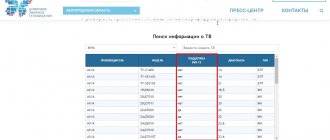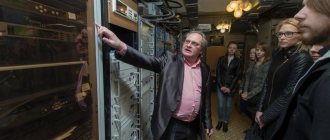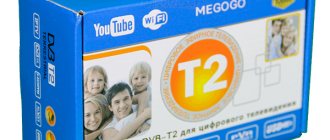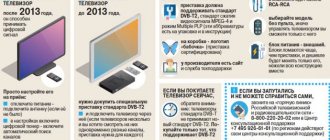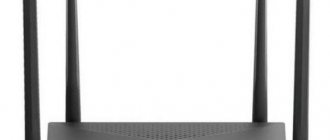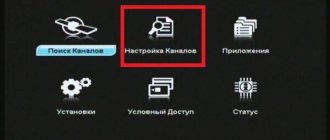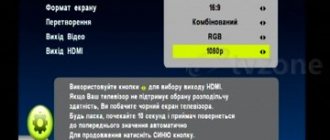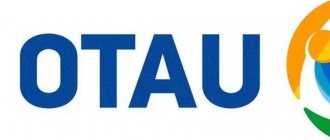Free DVB-T2 digital television channels are received from the Ostankino television tower and local repeaters. The main three frequencies for tuning by number: 30 - 546 MHz, 24 - 498 MHz, 34 - 578 MHz. Also, several more frequencies are used in the Moscow region; you can find a list of transmitters with their parameters on the coverage area page, and here is a prevention schedule. How many digital channels are tuned in your area depends on where the antenna is pointed, because... 30 units come from Ostankino, and only 20 from other TV towers. There are no plans to increase the number to three multiplexes on local towers. There are no pay TV or scrambled channels available.
First multiplex of digital channels
| Channel logo | Name | Number | Frequency (MHz) |
| First | 30 | 546 | |
| Russia 1 | 30 | 546 | |
| Match TV | 30 | 546 | |
| NTV | 30 | 546 | |
| Channel 5 | 30 | 546 | |
| Russia K | 30 | 546 | |
| Russia 24 | 30 | 546 | |
| Carousel | 30 | 546 | |
| OTR | 30 | 546 | |
| TV Center | 30 | 546 | |
| Vesti FM | 30 | 546 | |
| Lighthouse | 30 | 546 | |
| Radio Russia | 30 | 546 |
RTRS digital TV channels. Multiplexes RTRS-1 and RTRS-2.
Digital multiplexes.
Digital television channels transmitted on the same frequency are called multiplex. In a multiplex, the number of channels may vary. At the moment, the RTRS company broadcasts 10 television channels in one multiplex. The first multiplex also includes three radio channels. The second multiplex broadcasts only 10 TV channels. TV channels use standard SDTV resolution. Contrary to the assurances of unscrupulous marketers, broadcasting of digital TV channels in HDTV format is not yet used for terrestrial television. However, most DVB-T2 set-top boxes and digital TV sets on the market support the HDTV format. This means that if RTRS decides to launch broadcasts in high definition format, then viewers will not need to replace their equipment to watch digital TV channels. The channels of the digital first multiplex are available in all settlements of the Russian Federation. Broadcasting of the second multiplex is available in almost most of the Russian Federation. Nevertheless, the coverage radius of some repeaters in flat terrain reaches 100 kilometers. And if you have a high-quality antenna with a signal amplifier, you can receive digital television channels from both multiplexes at a considerable distance from large populated areas.
First digital multiplex (RTRS-1)
The first digital multiplex or the first package of digital channels of the Russian Television and Radio Broadcasting Network (RTRS-1) is a package of all-Russian, publicly accessible and free television and radio resources for the population.
The frequency-territorial plan of RTRS-1 was approved by the State Commission on Radio Frequencies in 2009. In 2012, the Russian government approved that the broadcast standard of the RTRS-1 digital package is DVB-T2, the format is SDTV standard definition. Broadcasting of the digital package in Russia is carried out in the decimeter range from 470 to 862 MHz. The first multiplex is broadcast free of charge without any encryption, which allows you to freely view these digital TV channels throughout Russia.
| No. | Logo | Name | format | Owner |
| 1 | First channel | 16:9 | OJSC "Channel One" | |
| 2 | Russia 1 | 4:3 | FSUE "All-Russian State Television and Radio Broadcasting Company" | |
| 3 | Match TV | 16:9 | JSC Gazprom-Media Holding | |
| 4 | NTV | 16:9 | OJSC "Television Company NTV" | |
| 5 | Channel 5 | 4:3 | OJSC "TV and Radio Company "Petersburg"" | |
| 6 | Russia-K | 4:3 | FSUE "All-Russian State Television and Radio Broadcasting Company" | |
| 7 | Russia 24 | 16:9 | FSUE "All-Russian State Television and Radio Broadcasting Company" | |
| 8 | Carousel | 4:3 | CJSC "Karusel" (FSUE "All-Russian State Television and Radio Broadcasting") | |
| 9 | Public television of Russia | 16:9 | ANO "Public Television of Russia" | |
| 10 | TV Center | 16:9 | OJSC "Television Company "TV Center"" |
Second digital multiplex (RTRS-2)
RTRS-2 or the second multiplex of digital terrestrial TV channels is another package of all-Russian, but not obligatory channels. The channels of the RTRS-2 digital package were compiled based on the results of a Roskomnadzor competition. If the RTRS-1 channel package is required for distribution across all networks for free. The distribution of the second multiplex for nothing remains to be considered by commercial operators on their own.
In 2009, the State Commission on Radio Frequencies assigned the decimeter range from 470 to 862 MHz to the second digital broadcasting package, the standard is DVB-T2, the format is standard definition SDTV. Broadcasting is carried out by FSUE RTRS.
The second broadcast package is distributed as free as the first. All channels of the second multiplex are well known to subscribers of satellite, cable and IPTV operators. These channels did not receive any special advantage when included in the RTRS-2 list, since they are not mandatory.
| No. | Logo | Name | format | Owner |
| 1 | REN TV | 16:9 | LLC "Accept" | |
| 2 | Saved | 4:3 | Financial economic management of the Russian Orthodox Church and SPAS-Media LLC | |
| 3 | STS | 4:3 | CJSC Network of Television Stations | |
| 4 | Home | 4:3 | CJSC "New Channel" | |
| 5 | TV-3 | 4:3 | Profmedia TV LLC | |
| 6 | Friday! | 4:3 | Profmedia TV LLC | |
| 7 | Star | 16:9 | OJSC "TRK RF Armed Forces "Zvezda"" | |
| 8 | World | 16:9 | CJSC "Interstate TV and Radio Company "Mir"" | |
| 9 | TNT | 4:3 | OJSC "TNT-Teleset" | |
| 10 | Muz TV | 4:3 | Muz TV Operating Company LLC |
The third digital television multiplex in Russia
The third digital multiplex is just a planned package, which will include federal and regional TV channels. The decree on the formation of RTRS-3 was signed by the President of Russia in 2013.
42, total, today
Liked it! Share with your friends.
Second multiplex of digital channels
| Channel logo | Name | Number | Frequency (MHz) |
| REN TV | 24 | 498 | |
| SAVED | 24 | 498 | |
| STS | 24 | 498 | |
| Home | 24 | 498 | |
| TV3 | 24 | 498 | |
| Friday | 24 | 498 | |
| Star | 24 | 498 | |
| WORLD | 24 | 498 | |
| TNT | 24 | 498 | |
| Muz TV | 24 | 498 |
What do you need to watch digital broadcasting?
Since DTTV is terrestrial television, no cables or expensive devices are required. You don't have to pay to watch TV programs. Excluding the moment of purchasing equipment, of course. But the costs here are not that great.
Digital receiver (receiver, set-top box) - on average costs 1.5 thousand rubles. The price depends on additional functions (viewing files via a flash drive, the ability to pause the broadcast, etc.).
Digital receiver REFLECT DIGITAL 2.0 - see specifications
Important - the receiver must support the DVB-T2 standard (not DVB-T - this is an outdated format!). If you have a regular (analog) TV, you definitely need a receiver. Modern TV models have a special built-in tuner; they do not require a set-top box.
TV antenna . The price depends on the type of antenna. Can you see the TV tower from the window? — an indoor antenna is enough (up to 1000 rubles). Perhaps a piece of wire will be enough for you, the only question is aesthetics - it is lame with homemade antennas.
If you, like the majority, do not have a TV tower in direct line of sight, you will need an outdoor antenna (500-2000 rubles).
Indoor antenna Reflect plus XA-1 Home - see specifications
Antenna amplifier . Contrary to popular belief, an amplifier does not necessarily improve the signal - sometimes it does the opposite. In a city where the signal is already strong, it can be over-amplified and you can get an “accordion-like” image. There are also antennas with a built-in amplifier - active antennas - this is also not always justified, especially for city apartments. An amplifier makes sense in areas remote from towers and/or where signal reception is interfered with by tall buildings and trees. Costs approximately 500 rubles.
TV cable . Don't skimp on this component, as often the problem of a bad image lies there. Choose a new cable, because... Even an unused cable loses its useful properties over time and becomes worse.
Bracket/Mast and Mounting . This mainly applies to outdoor antennas.
You can also come up with a beautiful solution for attaching indoor antennas (Pikabu)
Third multiplex of digital channels
On the third multiplex, programs are shown in a certain order, on each button there are several TV channels that replace each other. This is a way to avoid advertising laws. The channels, at their own expense, organized the broadcast of the third multiplex in Moscow and the Ostankino region, accumulate the required number of hours of free broadcasting and after that have the right to include advertising in their programs.
| Position | Channel logo | Name | Number | Frequency (MHz) | Broadcast time |
| 1 | TNT MUSIC | 34 | 578 | 00:00 — 24:00 | |
| 2 | 2×2 | 34 | 578 | 00:00 — 12:00 | |
| My planet | 34 | 578 | 12:00 — 18:00 | ||
| The science | 34 | 578 | 18:00 — 24:00 | ||
| 3 | Tlum HD | 34 | 578 | 00:00 — 05:00 | |
| FAN | 34 | 578 | 05:00 — 10:00 | ||
| Russian detective | 34 | 578 | 10:00 — 15:00 | ||
| TV channel "History" | 34 | 578 | 15:00 — 20:00 | ||
| Ani | 34 | 578 | 20:00 — 24:00 | ||
| 4 | Sundress | 34 | 578 | 00:00 — 12:00 | |
| Cartoon and music | 34 | 578 | 12:00 — 24:00 | ||
| 5 | NST | 34 | 578 | 00:00 — 03:00 | |
| Cinema | 34 | 578 | 03:00 — 06:00 | ||
| Planet HD | 34 | 578 | 06:00 — 09:00 | ||
| Doctor | 34 | 578 | 09:00 — 12:00 | ||
| Techno 24 | 34 | 578 | 12:00 — 15:00 | ||
| Mother | 34 | 578 | 15:00 — 18:00 | ||
| Living Planet | 34 | 578 | 18:00 — 24:00 | ||
| 6 | Moscow Trust | 34 | 578 | 00:00 — 12:00 | |
| Euronews | 34 | 578 | 12:00 — 24:00 | ||
| 7 | Home Cinema | 34 | 578 | 01:30 — 02:30 | |
| Time | 34 | 578 | 02:30 — 04:30 | ||
| TV cafe | 34 | 578 | 04:30 — 06:30 | ||
| Beaver | 34 | 578 | 06:30 — 08:30 | ||
| Music of the First | 34 | 578 | 08:30 — 01:30 | ||
| 8 | 365 days of TV | 34 | 578 | 00:00 — 02:00 | |
| TNT-4 | 34 | 578 | 02:00 — 04:00 | ||
| Film series | 34 | 578 | 04:00 — 06:00 | ||
| HD Life | 34 | 578 | 06:00 — 08:00 | ||
| ZEE TV | 34 | 578 | 08:00 — 10:00 | ||
| Indian film | 34 | 578 | 10:00 — 12:00 | ||
| Movie date | 34 | 578 | 12:00 — 14:00 | ||
| Comedy film | 34 | 578 | 14:00 — 16:00 | ||
| Kinomix | 34 | 578 | 16:00 — 18:00 | ||
| Men's cinema | 34 | 578 | 18:00 — 20:00 | ||
| Kitchen TV | 34 | 578 | 20:00 — 22:00 | ||
| Auto Plus | 34 | 578 | 22:00 — 24:00 | ||
| 9 | News | 34 | 578 | 00:00 — 24:00 | |
| 10 | Match Premier | 34 | 578 | Blocked |
If the indicated frequencies are not received or you do not know which direction to point the antenna, find your exact location on the interactive DTV map and click on it, the map will show in which direction the nearest tower is and at what frequency it broadcasts.
Channel multiplexing
Multiplex is usually called television and radio channels combined into a single digital block. These TV and radio channels are mixed (multiplexed) and transmitted via a special transport stream. On the receiving device (digital set-top box, digital tuner built into the TV), they are separated (demultiplexed).
In the case of digital multichannel television, transmission is carried out on a single frequency. The package may include channels of different formats and qualities (SD, HD, 3D). They are formed by various sources (TV and radio companies, operators, providers, etc.), while broadcasting streams, subtitles, teletext, TV guide, etc. are transmitted.
Digital television broadcast frequencies
The main difference from analogue broadcasting is that the operating frequency is allocated not to each channel, but to the whole package (multiplex). This allows you to significantly relieve the on-air network and provide access to a larger number of TV channels compared to analogue broadcasting. Note that in different regions the operating frequency for each multiplex will be different. This is due to the presence of a large number of regional television companies that have already occupied the corresponding bands.
As an example, here are the frequency channels of digital television for several large cities:
| Package name | Moscow | Nizhny Novgorod | Saint Petersburg | Ekaterinburg | Rostov-on-Don |
| 1 multiplex | 546 MHz | 530 MHz | 586 MHz | 674 MHz | 602 MHz |
| 2 multiplex | 498 MHz | 730 MHz | 666 MHz | 786 MHz | 610 MHz |
| 3 multiplex | 578 MHz |
As you can see, the required frequency bandwidth for receiving more than 30 channels is disproportionately small compared to similar indicators for analogue broadcasting. And the development of a network of repeaters will make it possible to provide almost all residents of Russia with information and entertainment content with high quality image transmission.
You can easily find out the data for your region online. Note that you will only need these numbers when manually tuning and searching for channels. When autosearching, you will not need to enter such data, so we recommend this method of setting up reception equipment.
Signal reception methods
When considering the number of TV channels that the tuner shows, you need to consider the connection method. There are several options here:
- Cable. The client enters into an agreement with the provider, who supplies the cable to the apartment. It must be connected to a set-top box to watch television. Which channels can be watched through a digital set-top box is determined by the service provider itself. Their number can reach hundreds or more. The downside is the need to pay a subscription fee.
- Satellite. Unlike the method discussed above, here it is necessary to install and configure the antenna for satellites. Next, the antenna is connected to the tuner, which displays TV. As in the previous case, a subscription fee is charged for watching such TV.
- Essential. This is the most beneficial solution for most people. It was noted above which channels are available on the digital set-top box - 20 channels from two multiplexes. This is a convenient and economical method for people who live a short distance from the repeater. But there is also a minus - in case of bad weather, catching a signal is very problematic.
Many users prefer the latter option. Under good circumstances, the tuner shows 20 channels, which is more than enough for most users. If the available package is not enough, you can always buy a satellite dish or connect to cable TV. Or use any other opportunity to increase the number of channels.
Broadcast frequencies
The third package of digital TV channels will broadcast according to the same principle as the first two. All programs will be broadcast on one physical TV channel (TVC) on a specific frequency. For the Moscow region, the third package is broadcast at a frequency of 578 MHz, which corresponds to 34 TVCs. However, it is not approved and is subject to change.
There are no reserved broadcast frequencies for regions yet, because... the problem of its selection is associated with a large number of regional programs.
How much does a digital set-top box cost?
The most budget model of a DVB-T2 set-top box will cost about 1,000 rubles, and depending on additional options, the cost can rise to 2,000 rubles. The presence of Wi-Fi increases the price by another thousand.
Smart-TV sticks start at 3,000 rubles, the cheapest TV box will cost 4,000 rubles. Set-top boxes with many additional functions, combining the capabilities of the Internet and television, and having impressive characteristics (RAM, processor) can cost more than 8,000 rubles.
How to choose digital set-top boxes for your TV? Individual needs must be taken into account. Thus, budget models of consoles are well suited for a summer house or garden, where numerous additional functions are not needed. Expensive and functional models are suitable for a home or apartment, provided that all functions will be constantly used. The choice of a suitable tuner should directly depend on the expected result.
How does a digital set-top box work?
Any digital set-top box consists of elements such as a housing, a receiving and processing board and a control panel. The set-top box works as follows: it receives a signal, converts it and broadcasts it to the TV either in analog format (via RCA or VGA connector, you need to switch the TV to signal mode with AV), or in digital format (via HDMI connector, you need to switch to signal from HDMI ). Using a set-top box can significantly increase the quality of television broadcasting, regardless of how modern the TV is. If desired, the set-top box can even be used to connect to a TV with a kinescope. At the same time, you need to understand that the quality of the broadcast depends, among other things, on the screen resolution.
